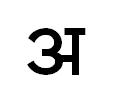Ka (Indic)
← Au | Ka | ||||
|---|---|---|---|---|---|
| Devanagari | Bengali | Gurmukhi | Gujarati | Oriya | |
| ਕ | ક | ||||
| Tamil | Telugu | Kannada | Malayalam | Sinhala | |
| க | క | ಕ | ക | ක | |
| Thai | Lao | Tibetan | Burmese | Khmer | |
| ก | ກ | ཀ | က | ក | |
| Baybayin | Hanunoo | Buhid | Tagbanwa | Lontara | |
| ᜃ | ᜣ | ᝃ | ᝣ | ᨀ | |
| Balinese | Sundanese | Limbu | Tai Le | New Tai Lue | |
| ᬓ | ᮊ | ᥐ | ᦂ | ||
| Lepcha | Saurashtra | Rejang | Javanese | Cham | |
| ᰀ | ꢒ | ꤰ | ꦏ | ꨆ | |
| Tai Tham | Tai Viet | Kayah Li | Phags-pa | Siddhaṃ | |
| ᨠ | ꪀꪁ | ꤊ | ꡀ | ||
| Mahajani | Khojki | Khudabadi | Syloti | Meitei | |
| 𑅕 | 𑈈 | 𑊺 | ꠇ | ꯀ | |
| Modi | Tirhuta | Kaithi | Sora | Grantha | |
| 𑘎 | 𑒏 | 𑂍 | 𑃟 | 𑌕 | |
| Chakma | Sharada | Takri | Kharoshthi | Brahmi | |
| 𑄇 | 𑆑 | 𑚊 | 𐨐 | 𑀓 | |
| Phonemic representation: | /k/ | ||||
| IAST transliteration: | ka | ||||
| ISCII code point: | B3 (179) | ||||
Ka is the first consonant of Indic abugidas. In modern Indic scripts, ka is derived from the Brahmi letter ![]() , which is (according to the Semitic hypothesis) derived from the Aramaic
, which is (according to the Semitic hypothesis) derived from the Aramaic ![]() ("K").
("K").
Mathematics
Āryabhaṭa numeration
Aryabhata used Devanagari letters for numbers, very similar to the Greek numerals, even after the invention of Indian numerals. The values of the different forms of क are:[1]
- क [kə] = 1 (१)
- कि [kɪ] = 100 (१००)
- कु [kʊ] = 10,000 (१० ०००)
- कृ [kri] = 1,000,000 (१० ०० ०००)
- कॢ [klə] = 1×108 (१०८)
- के [ke] = 1×1010 (१०१०)
- कै [kɛː] = 1×1012 (१०१२)
- को [koː] = 1×1014 (१०१४)
- कौ [kɔː] = 1×1016 (१०१६)
Tabla Strokes
In Tabla notation, क (ka) also seen as कि (ki), or के (ke) is a flat, nonresonant stroke of the left hand. The heel of the hand is left on the drum, while the hand rotates to hit the drum, with the focus of the force being focused between the tips and first joints of the fingers.
Hindu astrology
के (ke) is the abbreviation used for केतु (Ketu), the descending lunar node. In Hindu astrology Ketu represents karmic collections both good and bad, spirituality and supernatural influences. Ketu is associated with the Matsya Avatar (Fish Incarnation) of Vishnu. Ketu signifies the spiritual process of the refinement of materialization to spirit and is considered both malefic and benefic, as it causes sorrow and loss, and yet at the same time turns the individual to God. In other words, it causes material loss in order to force a more spiritual outlook in the person. Ketu is a karaka or indicator of intelligence, wisdom, non-attachment, fantasy, penetrating insight, derangement, and psychic abilities. Ketu is believed to bring prosperity to the devotee's family, removes the effects of snakebite and illness arising out of poisons. He grants good health, wealth and cattle to his devotees.
Historic Ka
The original Indic letter Ka is attested in three different forms. The first is in standard Brahmi, ![]() , the second in the Brahmi variant, Tocharian, also known as slanting Brahmi. The third form of Ka, in Kharoshthi (𐨐) was probably derived from Aramaic separately from the Brahmi letter.
, the second in the Brahmi variant, Tocharian, also known as slanting Brahmi. The third form of Ka, in Kharoshthi (𐨐) was probably derived from Aramaic separately from the Brahmi letter.
Brahmi Ka
The Brahmi letter ![]() , ka, is derived from the Aramaic
, ka, is derived from the Aramaic ![]() , K, and is related to the modern Latin K and Greek Kappa.
, K, and is related to the modern Latin K and Greek Kappa.
| K | Ka | Kā | Ki | Kī | Ku | Kū | Kr | Kr̄ | Kl | Kl̄ | Ke | Kai | Ko | Kau |
|---|---|---|---|---|---|---|---|---|---|---|---|---|---|---|
| | | | | | | | | | | | | | | |
Tocharian Ka
The Tocharian, also called slanting Brahmi, letter ![]() is a variant of the Brahmi
is a variant of the Brahmi ![]() .
.
| Ka | Kā | Ki | Kī | Ku | Kū | Kr | Kr̄ | Ke | Kai | Ko | Kau | Kä |
|---|---|---|---|---|---|---|---|---|---|---|---|---|
| | | | | | | | | | | | |
Kharoshthi Ka
Like its Brahmi counterpart, the Kharoshthi letter 𐨐 is also derived from the Aramaic ![]() , and is thus related to K and Kappa, in addition to the Brahmi ka.
, and is thus related to K and Kappa, in addition to the Brahmi ka.
Devanagari Ka
| Devanāgarī |
|---|
 |
|
Diacritics, punctuation, symbols |
Ka (क) (कवर्ण kavarn) is the first consonant of the Devanagari abugida. It ultimately arose from the Brahmi letter ![]() , after having gone through the Gupta letter
, after having gone through the Gupta letter ![]() . Letters that derive from it are the Gujarati letter ક, and the Modi letter 𑘎.
. Letters that derive from it are the Gujarati letter ક, and the Modi letter 𑘎.
Devanagari-using Languages
In all languages, क is pronounced as [kə] or [k] when appropriate.
- नकली = nakali [nəkəliː] "fake"
In this example, क implements its inherent vowel, the schwa.
- बकवास = bakvās [bəkʋaːs] "nonsense"
In this example, क deletes the inherent schwa for correct pronunciation.

Certain words that have been borrowed from Persian and Arabic implement the nukta to more properly approximate the original word. It is then transliterated as a q.
- क़दम = qəd̪əm [qadam] "footstep"
Conjuncts With क
- क् + त(t̪) gives us kt̪ with a somewhat irregular form.

- क् + ष(ʂ) gives us the fully ligated kʂ with a very irregular form.

- ङ्(ŋ) + क gives us the vertical conjuct ŋk with the ङ placed above the क.

- क् + ख(kʰ) gives us kkʰ with the क placed above the ख.
- क् + ल(l̪) gives us kl̪ with the क placed above the ल.
- क् + व(ʋ) gives us kʋ with the क placed above the व.
- क् + न(n̪) gives us kn̪ with the न rotated and placed under the hook of the क.
Bengali Ka
The Bengali script ক is derived from the Siddhaṃ ![]() , and is marked by a similar horizontal head line, but less geometric shape, than its Devanagari counterpart, क. The inherent vowel of Bengali consonant letters is /ɔ/, so the bare letter ক will sometimes be transliterated as "ko" instead of "ka". Adding okar, the "o" vowel mark, কো, gives a reading of /ko/.
, and is marked by a similar horizontal head line, but less geometric shape, than its Devanagari counterpart, क. The inherent vowel of Bengali consonant letters is /ɔ/, so the bare letter ক will sometimes be transliterated as "ko" instead of "ka". Adding okar, the "o" vowel mark, কো, gives a reading of /ko/.
Like all Indic consonants, ক can be modified by marks to indicate another (or no) vowel than its inherent "a".

ক in Bengali-using languages
ক is used as a basic consonant character in all of the major Bengali script orthographies, including Bengali and Assamese. It is also used with a nukta, ক়, for foreign borrowings of /q/.
Conjuncts with ক
Bengali ক exhibits conjunct ligatures, as is common in Indic scripts, with a tendency towards stacked ligatures.[2]
- ক্ + ষ [ʃ] gives us the irregular kʃa ligature. The conjunct functions as an independent letter in the Assamese orthography, with a different pronunciation than the Bengali ligature of ক্ + ষ.

- ক্ + স [s] preserves the ক, but reduces the স, giving

- ক্ + ক results in a stacked conjunct

- ঙ্ [ŋ] + ক also gives a stacked conjuct with a somewhat irregular form

- ক্ + র [ɾ] is a fully ligated (irregular) conjunct

Javanese Ka
References
- ↑ Ifrah, Georges (2000). The Universal History of Numbers. From Prehistory to the Invention of the Computer. New York: John Wiley & Sons. pp. 447–450. ISBN 0-471-39340-1.
- ↑ "The Bengali Alphabet" (PDF).
- Kurt Elfering: Die Mathematik des Aryabhata I. Text, Übersetzung aus dem Sanskrit und Kommentar. Wilhelm Fink Verlag, München, 1975, ISBN 3-7705-1326-6
- Georges Ifrah: The Universal History of Numbers. From Prehistory to the Invention of the Computer. John Wiley & Sons, New York, 2000, ISBN 0-471-39340-1.
- B. L. van der Waerden: Erwachende Wissenschaft. Ägyptische, babylonische und griechische Mathematik. Birkhäuser-Verlag, Basel Stuttgart, 1966, ISBN 3-7643-0399-9
- Fleet, J. F. (January 1911). "Aryabhata's System of Expressing Numbers". Journal of the Royal Asiatic Society of Great Britain and Ireland: 109–126. ISSN 0035-869X. JSTOR 25189823.
- Fleet, J. F. (1911). "Aryabhata's System of Expressing Numbers". The Journal of the Royal Asiatic Society of Great Britain and Ireland. Royal Asiatic Society of Great Britain and Ireland. 43: 109–126. doi:10.1017/S0035869X00040995. JSTOR 25189823.